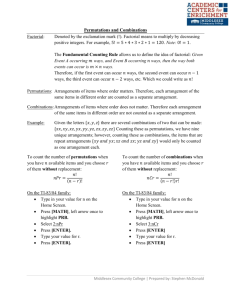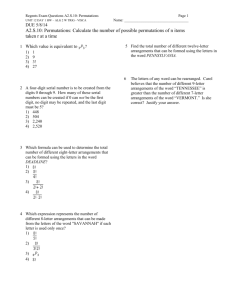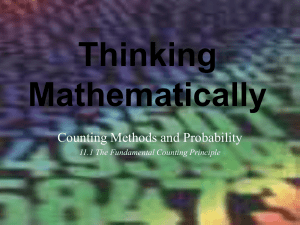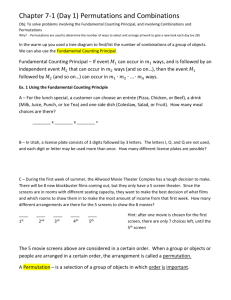Chapter 4 notes - Campbell Collegiate
advertisement
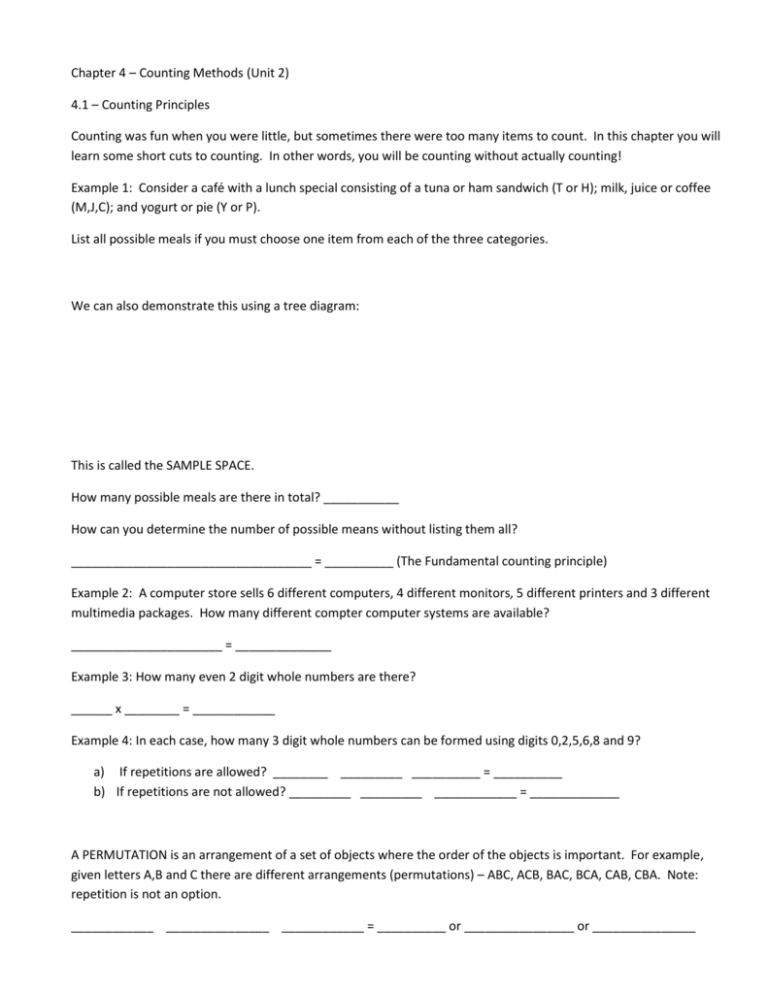
Chapter 4 – Counting Methods (Unit 2) 4.1 – Counting Principles Counting was fun when you were little, but sometimes there were too many items to count. In this chapter you will learn some short cuts to counting. In other words, you will be counting without actually counting! Example 1: Consider a café with a lunch special consisting of a tuna or ham sandwich (T or H); milk, juice or coffee (M,J,C); and yogurt or pie (Y or P). List all possible meals if you must choose one item from each of the three categories. We can also demonstrate this using a tree diagram: This is called the SAMPLE SPACE. How many possible meals are there in total? ___________ How can you determine the number of possible means without listing them all? ___________________________________ = __________ (The Fundamental counting principle) Example 2: A computer store sells 6 different computers, 4 different monitors, 5 different printers and 3 different multimedia packages. How many different compter computer systems are available? ______________________ = ______________ Example 3: How many even 2 digit whole numbers are there? ______ x ________ = ____________ Example 4: In each case, how many 3 digit whole numbers can be formed using digits 0,2,5,6,8 and 9? a) If repetitions are allowed? ________ _________ __________ = __________ b) If repetitions are not allowed? _________ _________ ____________ = _____________ A PERMUTATION is an arrangement of a set of objects where the order of the objects is important. For example, given letters A,B and C there are different arrangements (permutations) – ABC, ACB, BAC, BCA, CAB, CBA. Note: repetition is not an option. ____________ _______________ ____________ = __________ or ________________ or _______________ Example 5: How many arrangements can be made using the letters in the word MUSIC? _______________ _________ __________ __________ = ___________ or ____________ or ___________ Example 6: How many permutations can be formed using all the letters of the word CLARINET? Example 7: How many 4 letter permutations can be formed from the letters of the word CLARINET? Example 8: In how many ways can 1st, 2nd and 3rd place b awarded in a math class of 30 students? Page 235 #1-3 as a class #4,6,8, 15 4.2 – Factorial Notation Factorial Notation – is a concise representation of the product of consecutive descending natural numbers: N! = n(n-1)(n-2)(n-3)…(3)(2)(1). For example, 4! = (4)(3)(2)(1). Example 1: Evaluate the following: 13! a) 6! B) 4!9! Example 2: Simplify the following, where n is a natural number. a) (n+3)(n+2)! B) (𝑛−3)! 𝑛! Example 3: Solve the following equations given in factorial notation. a) 𝑛! (𝑛−2)! = 90 Page 243 #1-4 as a class, #5-7, 11,12 b) (𝑛+4)! (𝑛+2)! =6 4.3 – Permutations of Distinguishable Objects 𝑛! The number of permutations of n different objects taken r at a time is: nPr = (𝑛−𝑟)! Example 1: Matt has downloaded 10 new songs from an online music store. How many different 6-song play list can be created from 10 songs? Example2: How many 8 song play lists could Matt in example 1 create? Example 3: State the values of n for which each expression is defined. a) (n+3)! B) 𝑛! ((𝑛+2)! Example 4: An online magazine requires each subscriber to have a password with exactly 8 characters. The password can use any digits from 0 to 9 and/or any letters of the alphabet. The password is case sensitive, so she can use both lower and upper case letters. How many different passwords are possible? Example 5: How many different passwords are possible in example 4 if the password must be at least 4 characters but a maximum of 6 characters? Example 6: At a used car lot, seven different car models are to be parked close to the street for each viewing. a) The three red cars must be parked so that there is a red car at each end and the third car is exactly in the middle. How many ways can the seven cars be parked? b) The three red cars must be parked side by side. How many ways can the seven cars be parked? Page 255 #1-3 as a class, #5,6,9,13,15 4.4 – Permutations of Identical Objects In lesson 1, we determined the number of arrangements of objects when the objects were all different (ie the letters in CLARINET were all different). Now, let’s take any word that has two letters the same –ALL – and see how many different arrangements can be made. We will start by differentiating the :’s: AL1L2 This is 3! = 6 “different” arrangements. Realistically, though, without the subscripts numbers, AL1L2, is the same as AL2L1 and if we eliminated all such similar arrangements, we would be left with only _______ different 3! arrangements: 2! = ____________ If there are identical letters (or objects), we can still determine the number of different arrangements by dividing the original factorial by any (or all) identical objects. Example 1: How many ways are there to arrange the letters in the following words: a) BUBBLE b) MISSING c) MISSISSIPPI Example 2: How many 9 digit numbers can be formed using the numbers 1 1 2 2 2 3 3 3 3? Example 3: How many ways can 4 red, 3 blue, and 6 green marbles be distributed among 13 children, if each child is to receive 1 marble? Example 4: To play Lotto 6/49, you must choose six numbers from 1 to 49. To win, all six of your numbers must be chosen. How many different Lotto 6/49 tickets are possible? Pathways: Determine the number of ways Danny can get to each of his destinations if he must travel along the given paths, can only travel east or south and cannot backtrack. Danny’s trip to the theater is a complicated one, and one that can be determined without actually counting. He has to make a total of 11 direction decisions (but you can consider the 7 blocks east as identical and the 4 blocks south as identical). In other words, consider how many arrangements of EEEEEEESSSS there are. Page266 #1-3 as a class, #4-6,9,11 4.5/4.6 – Combinations It is important to know the difference between a permutation and a combination. The two formulas are: nPr 𝑛! = (𝑛−𝑟)! nCr 𝑛 =( )= 𝑟 𝑛! 𝑟!(𝑛−𝑟)! A permutation is an arrangement of a set of objects where order is important. A combination is a selection form a group of objects, where order is not important. Example 1: With Lotto 6/49, there is a selection of 6 numbers from 49. The Lottery Corporation jumbles 49 numbered balls in a cage and allows 6 balls to drop out. The order in which the six numbers appears is not important. Eventually, the numbers are rearranged from lowest to highest. How many arrangements of 6 numbers are possible? Example 2: How many different groups of 4 people can be chosen from a group of 30? Example 3: If the 4 people chosen were titled President, Vice-President, Treasurer, and Secretary, how many different groups can be formed from a group of 30 people? Example 4: There are 12 women and 8 men interested in committee work. a) Calculate the number of ways that a committee of 5 people can be chosen from this group if there must be exactly 3 women? b) Calculate the number of different groups of 5 that can be formed if there must be at least 3 women in each group. Example 5: Solve for n 4(nC2) = 2(nC1) Page 280 #1-3 as a class, #4-8,11,15,16 4.7 – Solving Counting Problems When solving counting problems, you need to determine if order plays a role in the situation. Once this is established, you can use the appropriate permutation (order matters) or combination (order doesn’t matter, choosing). Example 1: A piano teacher and her students are having a group photograph taken. There are three boys and 5 girls. The photographer wants the boys to sit together and the girls to sit together for one of the poses. How many ways can the students and teacher sit in a row of 9 chairs for this pose? Example 2: Combination problems are common in computer science. Suppose there is a set of 10 different data items represented by (a,b,c,d,e,f,g,h,I,j) to be placed into four different memory cells in a computer. Only 3 data items are to be placed in the first cell, 4 data items in the second cell, 2 data items in the third cell, and 1 data item in the last cell. How many ways can the 10 data items be placed in the four memory cells? Example 3: How many different five card hands that contain at most one black card can be dealt to one person from a standard deck of playing cards? Page 288 #1-3 as a class and #4-8,11,16

